PUBLICATIONS CITING ESSIG MUSEUM COLLECTIONS
Essig Museum specimens are fundamental to many research projects in taxonomy and systematics, ecology, biodiversity metrics, and environmental change. See the list of publications resulting from specimens and data curated by the Essig Museum. If you notice we are missing a publication, please email essig.museum[at]gmail.com with the citation.
GBIF CITATIONS – Publications citing Essig digitized specimen data aggregated by the Global BioInformatics Facility.
Checklists compiled by Essig Museum researchers.
Lepidoptera (butterflies & moths) of Albany Hill
The following list summarizes observations of Lepidoptera (moths and butterflies) at Albany Hill, Alameda Co., California, during 1995-1999. Data originate from about 75 daytime and crepuscular visits of 0.5 to 3.5 hrs, in all months of the year. All of the butterfly species and some of the moths were recorded by Bob Langston, most of the moth species and their larval host plants by Jerry Powell. A total of 145 species is recorded (30 butterflies, 115 moths), a modest number considering the extent and diversity of the flora.
ONLINE PUBLICATIONS
The Published Names of TDA Cockerell – Robert Zuparko (updated 2007, 2014). Theodore Dru Alison Cockerell (1866-1948) was an indefatigable scientist, teacher, and writer, whose publishing career reputably started at age 12 and continued until his death at 81, and included over 9,000 new scientific (Latinized) names. Early in his career he focused mostly on gastropods (slugs and snails) and homopterans (scales and mealybugs), but the bulk of his names are for bees. These names are presented here in 4 parts: Part I includes the Hymenoptera (bees, wasps and ants), Part II comprises all other Insecta, Part III includes all other taxa, and Part IV includes the unavailable names.
California Encyrtidae – Robert Zuparko (updated May 2018). This site presents keys to morphospecies from most of the genera of Encyrtidae found in California. This is a work in progress, and is presented here to help further the discourse of Encyrtidae taxonomy in an informal manner. For many genera, I didn’t have access to all of the holotypes, and thus I relied heavily upon written descriptions of the named species. For this reason alone, these keys should be considered provisional.
See also UC Entomology Research
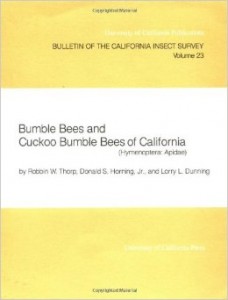
BULLETIN OF THE CALIFORNIA INSECT SURVEY
The California Insect Survey was formally initiated as a project in the Agricultural Experiment Station in 1940. It arose out a growing realization among entomologists that our knowledge of the most basic aspects of insect biology was far below the level required for effective application to agricultural and other practical problems. The strong systematic community in the San Francisco Bay area made an excellent point of genesis for such a program. A series of bulletins illustrate the diversity and composition of the terrestrial arthropod fauna of California, with an emphasis on native species and natural communities, and includes geographical and seasonal distributions, ecological ranges and biological relationships. See the full list of downloadable PDFs.
BOOKS
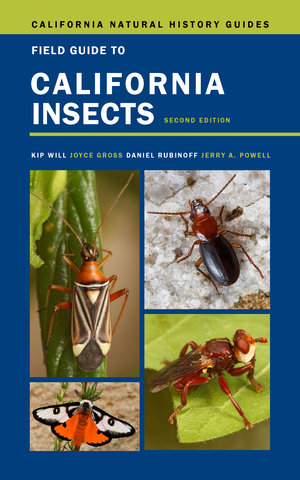 Field Guide to California Insects, 2nd Edition. 2020. Kip Will, Joyce Gross, Dan Rubinoff, & Jerry Powell. Completely revised for the first time in over 40 years, Field Guide to California Insects now includes over 600 insect species, each beautifully illustrated with color photographs. Engaging accounts focus on distinguishing features, remarkable aspects of biology, and geographical distribution in the state. An accessible and compact introduction to identifying, understanding, and appreciating these often unfamiliar and fascinating creatures, this guide covers insects that readers are likely to encounter in homes and natural areas, cities and suburbs, rural lands and wilderness. It also addresses exotic and invasive species and their impact on native plants and animals. Field Guide to California Insects remains the definitive portable reference and a captivating read for beginners as well as avid naturalists.
Field Guide to California Insects, 2nd Edition. 2020. Kip Will, Joyce Gross, Dan Rubinoff, & Jerry Powell. Completely revised for the first time in over 40 years, Field Guide to California Insects now includes over 600 insect species, each beautifully illustrated with color photographs. Engaging accounts focus on distinguishing features, remarkable aspects of biology, and geographical distribution in the state. An accessible and compact introduction to identifying, understanding, and appreciating these often unfamiliar and fascinating creatures, this guide covers insects that readers are likely to encounter in homes and natural areas, cities and suburbs, rural lands and wilderness. It also addresses exotic and invasive species and their impact on native plants and animals. Field Guide to California Insects remains the definitive portable reference and a captivating read for beginners as well as avid naturalists.
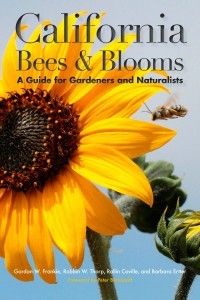
California Bees and Blooms: A Guide for Gardeners and Naturalists. 2014. Gordon Frankie, Robbin Thorp, Rollin Coville, & Barbara Ertter. Heyday press. 304 pages. California is home to over sixteen hundred species of undomesticated bees—most of them native—that populate and pollinate our gardens, fields, and urban green spaces. In this absorbing guidebook, some of the state’s preeminent bee and botany experts introduce us to this diverse population. California Bees and Blooms holds a magnifying glass up to the twenty-two most common genera (and six species of cuckoo bees), describing each one’s distinctive behaviors, social structures, flight season, preferred flowers, and enemies. Enhancing these descriptions are photographs of bees so finely detailed they capture pollen scattered across gauzy wings and iridescent exoskeletons.
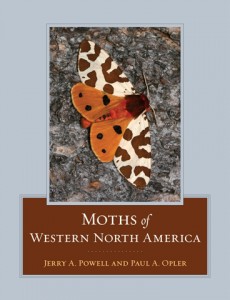 Moths of Western North America. 2009. Jerry Powell & Paul Opler. UC Press. 383 pages. Insects boast incredible diversity, and this book treats an important component of the western insect biota that has not been summarized before—moths and their plant relationships. There are about 8,000 named species of moths in our region, and although most are unnoticed by the public, many attract attention when their larvae create economic damage: eating holes in woolens, infesting stored foods, boring into apples, damaging crops and garden plants, or defoliating forests. In contrast to previous North American moth books, this volume discusses and illustrates about 25% of the species in every family, including the tiny species, making this the most comprehensive volume in its field. With this approach it provides access to microlepidoptera study for biologists as well as amateur collectors. About 2,500 species are described and illustrated, including virtually all moths of economic importance, summarizing their morphology, taxonomy, adult behavior, larval biology, and life cycles.
Moths of Western North America. 2009. Jerry Powell & Paul Opler. UC Press. 383 pages. Insects boast incredible diversity, and this book treats an important component of the western insect biota that has not been summarized before—moths and their plant relationships. There are about 8,000 named species of moths in our region, and although most are unnoticed by the public, many attract attention when their larvae create economic damage: eating holes in woolens, infesting stored foods, boring into apples, damaging crops and garden plants, or defoliating forests. In contrast to previous North American moth books, this volume discusses and illustrates about 25% of the species in every family, including the tiny species, making this the most comprehensive volume in its field. With this approach it provides access to microlepidoptera study for biologists as well as amateur collectors. About 2,500 species are described and illustrated, including virtually all moths of economic importance, summarizing their morphology, taxonomy, adult behavior, larval biology, and life cycles.
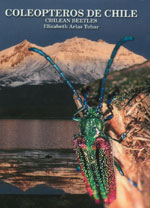 Coleopteros de Chile [Coleoptera of Chile]. 2000. Elizabeth Arias. 208 pages. A Spanish-language book featuring numerous photographs and illustrations of a diverse array of Chilean beetles. The book also provides information for each beetle pictured, including its family, habitat, and geographic distribution in Chile. Copies of the book are available for sale. Please contact Dr. Arias for information.
Coleopteros de Chile [Coleoptera of Chile]. 2000. Elizabeth Arias. 208 pages. A Spanish-language book featuring numerous photographs and illustrations of a diverse array of Chilean beetles. The book also provides information for each beetle pictured, including its family, habitat, and geographic distribution in Chile. Copies of the book are available for sale. Please contact Dr. Arias for information.
